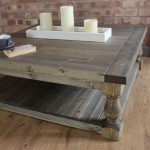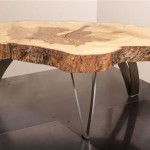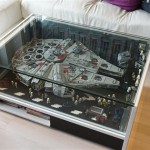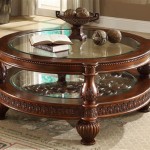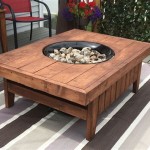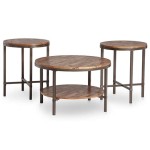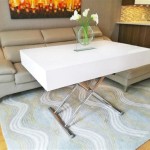Round Side Table Plans: A Comprehensive Guide to Design and Construction
Round side tables offer both functional utility and aesthetic appeal to a variety of living spaces. Their compact footprint and adaptable design make them suitable for placement beside sofas, beds, and armchairs, providing a convenient surface for lamps, beverages, books, or decorative items. Constructing a round side table can be a rewarding woodworking project, allowing for personalization and cost-effectiveness compared to purchasing pre-made furniture. Successful execution, however, relies on careful planning, material selection, and adherence to sound construction techniques. This article will explore essential considerations for developing and implementing round side table plans.
Key Considerations in Round Side Table Design
The design phase is crucial for creating a round side table that meets specific needs and stylistic preferences. Several factors should be considered before commencing the actual construction process.
Dimensions and Proportions: The height and diameter of the round table top are fundamental parameters. The height should be determined by the intended use and the furniture it will accompany. A table intended for use beside a sofa should generally be approximately the same height as the sofa arm. The diameter of the table top will dictate the available surface area. Smaller diameters are ideal for tight spaces, while larger diameters may be more suitable for holding multiple items or making a more substantial visual statement. The proportions between the table top and the base are also important; a very large table top on a slender base may appear unstable, while a small table top on a bulky base may look unbalanced.
Style and Aesthetics: The style of the round side table should complement the existing décor of the room. Consider the overall aesthetic – modern, traditional, rustic, or minimalist. This will influence the choice of materials, finishes, and decorative elements. A modern table might feature clean lines, simple geometry, and metal or glass accents, while a traditional table might incorporate turned legs, carved details, and a rich wood finish. The edge profile of the table top – rounded, beveled, or square – can also contribute to the overall style.
Functionality and Features: Determine the primary function of the table. Will it be used solely as a surface for holding items, or will it incorporate additional features such as a drawer, a shelf, or a storage compartment? These features will add complexity to the design and construction process, but can significantly enhance the table's functionality. Consider also the weight-bearing capacity required, particularly if heavy items are expected to be placed on the table.
Material Selection and Preparation
The choice of materials significantly impacts the appearance, durability, and cost of the round side table. Careful consideration should be given to the properties of different materials and their suitability for the intended application.
Wood Types: Hardwoods such as maple, oak, cherry, and walnut are popular choices for furniture construction due to their strength, durability, and attractive grain patterns. Softwoods such as pine and fir are less expensive, but are also less resistant to dents and scratches. The choice of wood should be influenced by the desired aesthetic and the intended level of use. For example, a table intended for frequent use might benefit from the greater durability of a hardwood. MDF (Medium-Density Fiberboard) and plywood can also be used, particularly for the table top, but may require veneering or painting to achieve a desired finish.
Hardware and Fasteners: Select appropriate hardware and fasteners for connecting the various components of the table. Screws, dowels, and wood glue are commonly used. The size and type of screws should be chosen based on the thickness and type of wood being used. Dowels can provide additional strength and alignment for joints. Wood glue should be used in conjunction with screws or dowels to create a strong and permanent bond. Consider using specialized joinery techniques, such as mortise and tenon joints or dovetail joints, for increased strength and aesthetic appeal. These techniques require more advanced woodworking skills and specialized tools.
Finishes and Coatings: The finish applied to the table will protect the wood from moisture, scratches, and UV damage, while also enhancing its appearance. Common finishes include polyurethane, varnish, lacquer, and oil. Polyurethane is a durable and water-resistant finish that is well-suited for furniture. Varnish provides a similar level of protection, but may require more coats to achieve the desired level of durability. Lacquer is a fast-drying finish that provides a smooth and glossy surface, but requires specialized equipment for application. Oil finishes penetrate the wood and provide a natural look and feel, but offer less protection than polyurethane or varnish. Choose a finish that is appropriate for the wood type and the intended level of use. Consider also the desired sheen – matte, satin, or gloss.
Construction Techniques and Assembly
The construction phase involves cutting, shaping, and joining the various components of the round side table. Precision and attention to detail are essential for achieving a professional-looking result.
Cutting and Shaping the Table Top: The round table top can be cut from a square or rectangular piece of lumber using a jigsaw, a bandsaw, or a router with a circle-cutting jig. A template can be used to ensure a consistent and accurate circle. After cutting the circle, the edges should be sanded smooth. Consider using a router with an edge-forming bit to create a decorative edge profile.
Leg Design and Attachment: The legs can be designed in a variety of styles, including straight legs, tapered legs, cabriole legs, or hairpin legs. Straight legs are the simplest to fabricate, while tapered legs require more complex shaping techniques. Cabriole legs are characterized by their S-shaped curve and are often used in traditional furniture styles. Hairpin legs are made from metal and provide a modern and minimalist look. The legs can be attached to the table top using screws, dowels, or mortise and tenon joints. The angle of the legs can influence the stability of the table; splayed legs provide greater stability than straight legs.
Assembly and Finishing: After all the components have been cut and shaped, the table can be assembled. Apply wood glue to all joints and clamp the components together until the glue has dried. Reinforce the joints with screws or dowels as needed. After the glue has dried, sand the entire table smooth, paying particular attention to the joints. Apply the desired finish according to the manufacturer's instructions. Multiple coats may be required to achieve the desired level of protection and appearance. Allow the finish to dry completely between coats. After the final coat has dried, lightly buff the surface with fine steel wool or sandpaper to remove any imperfections. Apply wax or furniture polish to protect the finish and enhance its sheen.
In addition to these core elements, further design considerations could involve incorporation of inlays, segmented construction of the table top for visual interest, or the utilization of recycled materials. The key to a successful outcome resides in detailed planning, meticulous execution, and a firm grasp of fundamental woodworking principles.

Simple Round Side Table Kreg Tool

Diy End Table Angela Marie Made

Build A Round Side Table Basic

Diy Round Side Table Shanty 2 Chic

Build A Round Side Table Basic

Benchright Round End Tables Ana White

Diy End Table Angela Marie Made

Diy Round Coffee Table

Makeover Monday Round Trestle End Table Free Plans Diy Tables Wood Furniture

More Like Home Round Coffee Tables 4 Easy To Build Styles Day 10
Related Posts

